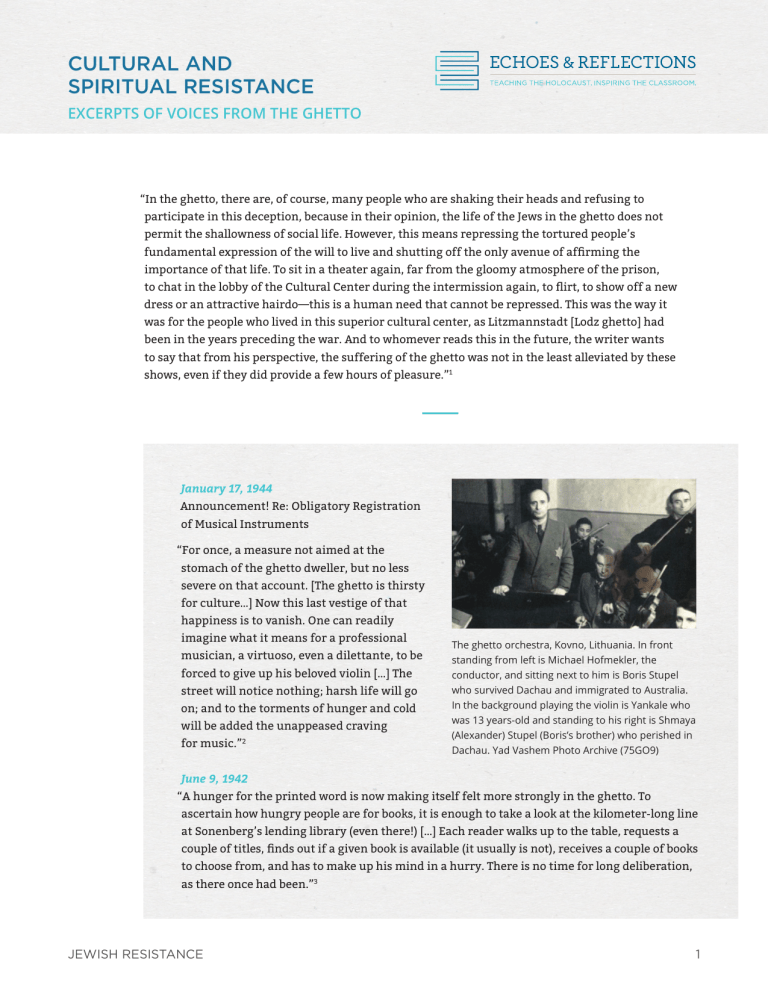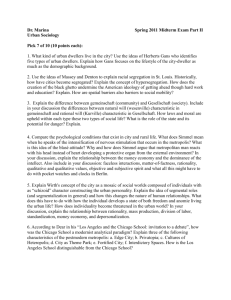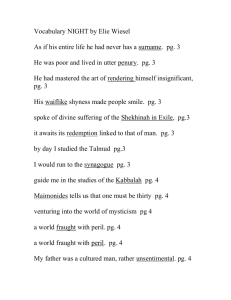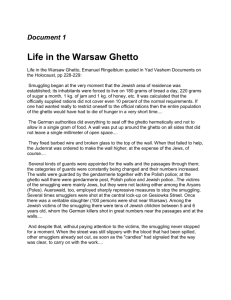Reading
advertisement

CULTURAL AND SPIRITUAL RESISTANCE EXCERPTS OF VOICES FROM THE GHETTO “In the ghetto, there are, of course, many people who are shaking their heads and refusing to participate in this deception, because in their opinion, the life of the Jews in the ghetto does not permit the shallowness of social life. However, this means repressing the tortured people’s fundamental expression of the will to live and shutting off the only avenue of affirming the importance of that life. To sit in a theater again, far from the gloomy atmosphere of the prison, to chat in the lobby of the Cultural Center during the intermission again, to flirt, to show off a new dress or an attractive hairdo—this is a human need that cannot be repressed. This was the way it was for the people who lived in this superior cultural center, as Litzmannstadt [Lodz ghetto] had been in the years preceding the war. And to whomever reads this in the future, the writer wants to say that from his perspective, the suffering of the ghetto was not in the least alleviated by these shows, even if they did provide a few hours of pleasure.”1 January 17, 1944 Announcement! Re: Obligatory Registration of Musical Instruments “For once, a measure not aimed at the stomach of the ghetto dweller, but no less severe on that account. [The ghetto is thirsty for culture…] Now this last vestige of that happiness is to vanish. One can readily imagine what it means for a professional musician, a virtuoso, even a dilettante, to be forced to give up his beloved violin […] The street will notice nothing; harsh life will go on; and to the torments of hunger and cold will be added the unappeased craving for music.”2 The ghetto orchestra, Kovno, Lithuania. In front standing from left is Michael Hofmekler, the conductor, and sitting next to him is Boris Stupel who survived Dachau and immigrated to Australia. In the background playing the violin is Yankale who was 13 years-old and standing to his right is Shmaya (Alexander) Stupel (Boris’s brother) who perished in Dachau. Yad Vashem Photo Archive (75GO9) June 9, 1942 “A hunger for the printed word is now making itself felt more strongly in the ghetto. To ascertain how hungry people are for books, it is enough to take a look at the kilometer-long line at Sonenberg’s lending library (even there!) […] Each reader walks up to the table, requests a couple of titles, finds out if a given book is available (it usually is not), receives a couple of books to choose from, and has to make up his mind in a hurry. There is no time for long deliberation, as there once had been.”3 JEWISH RESISTANCE 1 March 4, 1941 “The soup kitchen for the intelligentsia is a regular meeting place of the who’s who […] Only here do they at least have an illusion of things they had become accustomed to in the old days: a certain degree of courtesy [by the staff] in their conduct and attitude toward those who are now destitute and stripped of their status […] […] From time to time, the kitchen management organized reading and poetry evenings and concerts. The aim was to give the ghetto inhabitants cultural entertainment and provide financial support for the artists. […] The moments spent in kitchen number 2 – […] those are also moments of an exchange of opinions, something like a club in which those people, the who’s who meet over lunch.”4 “The kloyz [small synagogue] is almost full. The cantor prays melodiously; you would never know from him and the worshippers that the world is on the brinks of an abyss. They are wearing prayer shawls and tefillin. If you closed your eyes for a moment and did not look at these people, at their skinny faces… but just listened to the hum of their prayers, you would be sure you had fallen into a house of God in a time of peace and tranquility. There are young people, too, among the worshippers, and not just a few. They, too, are Jews in prayer shawls praying in a synagogue in the ghetto, Warsaw, Poland. Yad Vashem Photo Archive (1605/858) participating in creating an atmosphere in which the physical is forgotten and the soul is dedicated to sublime, lofty service totally removed from the oppression of the body and making the suffering of the moment pale in significance… I was suddenly suffused with warmth that I hadn’t felt since before the war. Someone, something, lifted me, carried me, and placed me in a congregation of Jews from the Middle Ages who were fighting and dying for their religion…. In the world—murder, violence, robbery and fraud; the street, cold; in the heart, anguish and pain; but above them all there hovers a different force, supreme and eternal—the power of past and future generations.”5 —Reuven Feldshaw “The living spirit behind the school was Yitzhak Katzenelson [Warsaw ghetto]. He was our most respected and popular teacher. His specialty was Bible, and he taught his students to love their people and their heritage, and to strive for national independence. His enthusiasm was contagious and at its height he would start singing and his students and the family in whose apartment they were studying would soon join in. It was usually very difficult to find classrooms in apartments, but there was never a problem in securing one for Katzenelson’s lessons.”6 JEWISH RESISTANCE 2 “Under conditions of this sort we celebrated Purim, 5701. The Book of Esther was not read in the darkened synagogues, because all public worship is prohibited; but we were happy about the defeat of the Persian Haman. We celebrated Purim in the Zionist soup kitchen at 13 Zamenhof Street, which is the center of all Hebrew-Zionist social activity. Here we always find the atmosphere and the warmth of Zionism. Every so often programs are put on with lectures, songs, instrumental music and recitations. When we come here we forget our troubles and all the terrible events taking place outside. Here you can hear debates and sermons, arguments and quarrels as in the good days. And when your throat is dry you can wet it with a glass of black coffee without sugar. […] This year we read the Scroll in the Sephardic pronunciation; then we sang the holiday songs accompanied by a piano, and between one number and the other we even had a bite-three pieces of bread spread with butter, a taste of the traditional poppy-seed tarts, and a glass of sweetened coffee. Credit for this heroic achievement goes to Dr. I. Schiper, M. Kirszenbaum, Bloch, and Kaminar. We came sad and left sad, but we had some pleasant moments in between—God remember these men with favor!”7 1 Arie Ben-Menachem, The Lodz Ghetto Chronicles, Vol. 3, trans. from Hebrew by Marion Duman (Jerusalem: Yad Vashem, 1988), 305. 2 Lucjan Dobroszycki, The Chronicle of the Lodz Ghetto, 1941–1944 (New Haven, CT: Yale University Press, 1984), 434. 3 Ibid., at 201–202. 4 Ibid., at 28–30. 5 Reprinted with permission from Yad Vashem Archive O.3/959. 6 Zivia Luberkin, In the Days of Destruction and Revolt (Israel: The Ghetto Fighters’ House, 1981), 69. 7 Chaim A. Kaplan, The Warsaw Ghetto Diary of Chaim A. Kaplan (New York: Collier Books, 1973), 256. JEWISH RESISTANCE 3




